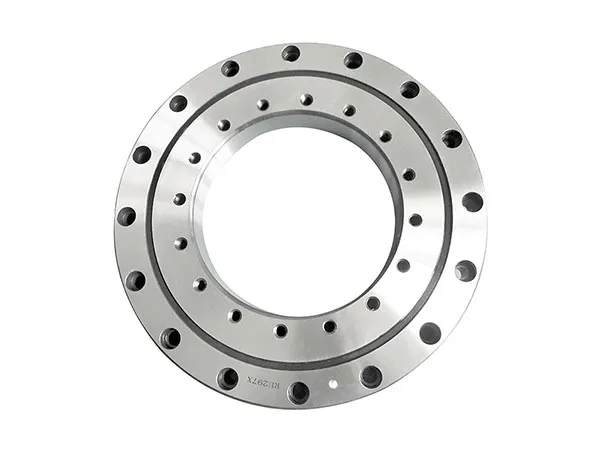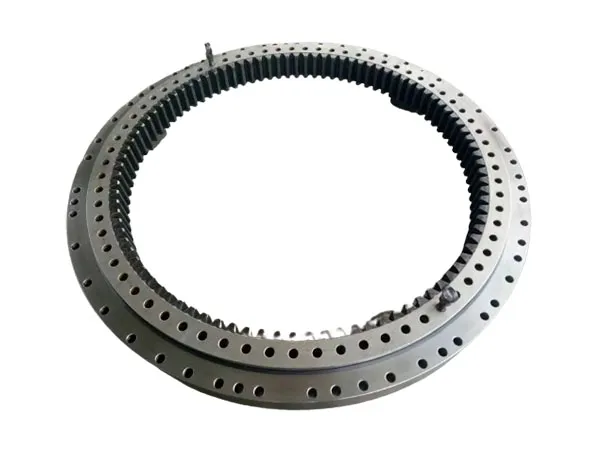- +86 13837949030 +86 15890619536
- info@lymcbearings.com export@lymcbearings.com
- Luoxin Industrial Cluster, Luoyang City,Henan Province,China
Time:2025-07-23 06:15:18 Source:LYMC Slewing Bearing
Double-row slewing bearings are critical components in heavy machinery, designed to handle significant axial, radial, and moment loads while enabling rotational movement. Due to the demanding environments they operate in, they are susceptible to various faults. Understanding these common issues and their solutions is crucial for maintaining equipment performance and longevity.

Abnormal Noise (Clicking, Grinding, Squealing, or Rattling):
Causes:
Insufficient or Improper Lubrication: Lack of grease, deteriorated grease, or using the wrong type of lubricant.
Foreign Objects in Raceway: Dust, dirt, metal particles, or other debris entering the bearing.
Severe Raceway or Rolling Element Wear: Pitting, spalling, or other damage due to fatigue, corrosion, or contamination.
Loose Mounting Bolts: Allowing movement between the bearing and its mounting surface.
Poor Meshing of Gears: Improper clearance between the slewing bearing's gear and the pinion, or damaged/broken teeth.
Bearing Overload: Exceeding the bearing's design load capacity.
Internal Faults: Such as a damaged cage, inner/outer ring, or balls.
Symptoms: Loud, unusual sounds during rotation, especially under load.
Lack of Flexibility in Rotation (Stiffness, Slow Movement, or Jamming):
Causes:
Insufficient Lubrication: Grease becoming viscous, especially in cold weather, or simply not enough lubrication.
Foreign Objects in Raceway: Blocking the rolling elements.
Overload Operation: Causing damage to the raceway.
Improper Installation: Uneven mounting surface, resulting in uneven force distribution or the bearing being in a negative clearance state.
Damaged Sealing Strips: Allowing foreign objects or moisture to enter.
Bearing Deformation: Due to excessive load or manufacturing defects.
Excessive Clearance: Leading to "wild movement" or looseness.
Symptoms: Difficulty in rotating the slewing platform, jerky movement, or complete inability to rotate.
Oil Leakage:
Causes:
Frequent Lubricant Filling: Over-greasing can push lubricant out of seals.
Thinned Lubricant: Due to mixing with hydraulic fluid or gear oil, or high temperatures.
Incorrect Lubricant Type: Not suitable for the operating temperature.
Damaged or Loose Oil Seals: Wear, aging, or improper installation of the sealing rings.
Deformed Bearing Housing: Allowing oil to escape.
Symptoms: Visible grease or oil leaking from the bearing seals or housing.
Excessive Vibration:
Causes:
Loose Mounting Bolts: Allowing the bearing or equipment to vibrate.
Uneven Mounting Surface: Leading to uneven force distribution.
Damaged or Loose Rolling Elements: Causing imbalance during rotation.
Overload: Exceeding the design load.
Damaged Gears or Shafts: Leading to imbalance and vibration.
Symptoms: Shaking or trembling of the rotating structure.
Corrosion:
Causes:
Exposure to Moisture or Corrosive Chemicals: Especially in harsh environments.
Poor Storage Conditions: Before installation.
Insufficient Rust Inhibitor: In the lubricant.
Damaged Seals: Allowing contaminants in.
Symptoms: Visible rust or pitting on the bearing surfaces.
Broken Teeth (on the integral gear):
Causes:
Improper Meshing Clearance: Between the slewing bearing's gear and the drive pinion.
Overload or Impact Loads: Exceeding the gear's strength.
Material Defects: In the gear teeth.
Wear: Leading to weakened teeth.
Radial Extrusion: Due to tilting moment in the system.
Symptoms: Grinding noises, sudden stops, or complete failure of the rotation mechanism.

For Abnormal Noise & Lack of Flexibility:
Lubrication:
Regular Greasing: Follow manufacturer recommendations (e.g., every 100-250 hours for ball bearings, 50 hours for roller bearings). Use the specified type of extreme pressure (EP2) grease.
Proper Greasing Technique: Slowly rotate the bearing while greasing to ensure even distribution. Avoid "static oiling" or "single point oiling."
Check Old Grease: Wipe off expelled grease and inspect for grit or metal debris, which indicates internal damage.
Replace Deteriorated Grease: If the grease has thinned or shows signs of contamination, clean and refill.
Inspection and Cleaning:
Check for Foreign Objects: Remove sealing rings (if accessible) and inspect the raceway for debris.
Clean Regularly: Prevent buildup of dirt, dust, and other contaminants around the bearing.
Installation & Alignment:
Ensure Flat Mounting Surface: Re-machine or use shims to correct any unevenness in the mounting foundation. This ensures even load distribution and prevents negative clearance.
Adjust Gear Clearance: Ensure proper backlash between the slewing ring gear and the drive pinion (e.g., 0.05 x module minimum).
Tighten Mounting Bolts: Follow the specified torque sequence (e.g., diagonal principle) and re-tighten after initial operation (e.g., after 100-500 hours) and then regularly (e.g., every 1000 hours). Replace bolts if they show signs of damage or reduced tensile strength.
Load Management:
Avoid Overload: Ensure the equipment operates within the bearing's design load capacity. Reduce load if necessary.
Check Preload: Ensure proper preload setting according to manufacturer's specifications.
For Oil Leakage:
Lubrication Frequency: Adhere to recommended lubrication intervals to avoid over-greasing.
Lubricant Type: Use the correct type of lubricant for the operating conditions.
Check for Internal Leaks: Inspect if hydraulic oil or gear oil from other components (e.g., hydraulic motor, reducer) is leaking into the slewing bearing cavity.
Inspect and Replace Seals: Check for damage, wear, or looseness of the outer and inner oil seals. Replace damaged seals promptly.
Address Housing Deformation: If the bearing housing is deformed, it may need repair or replacement.
For Excessive Vibration:
Tighten Mounting Bolts: As described above, ensure all bolts are properly torqued.
Check Mounting Surface: Ensure it's flat and rigid.
Inspect Internal Components: If vibrations persist, the bearing may have internal damage (e.g., worn rolling elements, damaged cage) requiring disassembly and replacement.
Assess Load: Verify the equipment load is within limits.
Check for Deformed Shafts/Gears: These can also contribute to vibration.
For Corrosion:
Improve Storage: Store bearings in a covered, dry, and dust-free environment.
Proper Packaging: Ensure adequate rust protection during shipping and storage.
Use Proper Lubricant: With sufficient rust inhibitors.
Maintain Seals: Ensure seals are intact to prevent moisture and chemical intrusion.
For Broken Teeth:
Adjust Gear Backlash: Correctly set the clearance between the slewing bearing's gear and the drive pinion.
Consider Helical Gears: If applicable, helical gears can offer better load distribution.
Check for Radial Extrusion: Address any issues causing excessive tilting moment that puts stress on the gear teeth.
Replace Damaged Bearing: If teeth are broken, the bearing typically needs to be replaced.

Regular Visual Inspection: Look for signs of wear, corrosion, oil leakage, and loose bolts.
Vibration Analysis: Can detect subtle changes in bearing condition before major failures occur.
Oil Analysis: Inspect lubricant for contaminants (e.g., metal particles) which indicate wear or damage.
Temperature Monitoring: Excessive heat can indicate lubrication issues or internal damage.
Deflection Measurement: Measure the total deflection under a known load to assess bearing wear and play.
Maintenance Logbook: Keep detailed records of inspections, lubrication, and any issues encountered.
By implementing a comprehensive maintenance program and promptly addressing any abnormal symptoms, the service life and reliability of double-row slewing bearings can be significantly extended. If severe damage is suspected, it's best to consult with the bearing manufacturer or a qualified service technician.